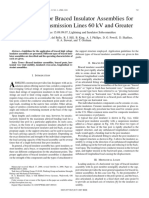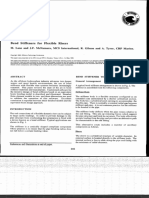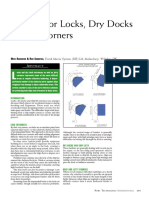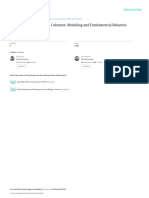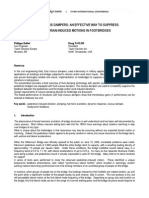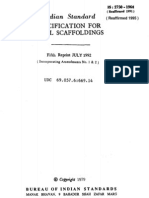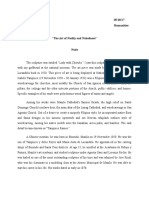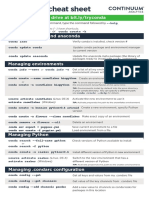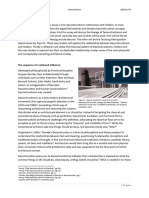1987 - ASCE - Polyzois, Dimos - Sag Rods As Lateral Supports For Girts and Purlins
1987 - ASCE - Polyzois, Dimos - Sag Rods As Lateral Supports For Girts and Purlins
Uploaded by
Robert VochescuCopyright:
Available Formats
1987 - ASCE - Polyzois, Dimos - Sag Rods As Lateral Supports For Girts and Purlins
1987 - ASCE - Polyzois, Dimos - Sag Rods As Lateral Supports For Girts and Purlins
Uploaded by
Robert VochescuOriginal Title
Copyright
Available Formats
Share this document
Did you find this document useful?
Is this content inappropriate?
Copyright:
Available Formats
1987 - ASCE - Polyzois, Dimos - Sag Rods As Lateral Supports For Girts and Purlins
1987 - ASCE - Polyzois, Dimos - Sag Rods As Lateral Supports For Girts and Purlins
Uploaded by
Robert VochescuCopyright:
Available Formats
SAG R O D S AS LATERAL SUPPORTS FOR GIRTS
AND FURLINS
By D i m o s Polyzois, 1 A. M . ASCE
ABSTRACT: Although cold-formed sections provide substantial savings, be-
cause of their high strength-to-weight ratio, their cross-sectional configuration
Downloaded from ascelibrary.org by New York University on 05/10/15. Copyright ASCE. For personal use only; all rights reserved.
gives rise to behavioral phenomena not encountered in the more familiar hot-
rolled sections. Of great concern to structural engineers is the tendency of these
members to deform under most conditions of loading and to fail by yielding
or local buckling as a result of the stresses developed. Channels and Z-sections
are commonly used as girts and purlins. In many installations, sag rods are
used to provide alignment for these members for the attachment of the steel
panels and to reduce their tendency to bend laterally and twist. Test results
indicate that the presence of sag rods may not always be beneficial to the girts
or purlins and, in fact, may cause premature distortional buckling of the
compression flange.
INTRODUCTION
Light gage cold-formed steel channel and Z-sections are commonly
used to support wall and roofing materials, which usually consist of steel
panels. Since these sections are not symmetric and since the load is usu-
ally applied through the flanges, they will bend and twist unless ade-
quate lateral and rotational supports are provided. The steel panels could
possibly serve as a bracing system and thus help reduce the lateral and
rotational movements of these members. Ref. 13 states that:
Channel a n d Z-sections used to support attached covering material
and loaded in a plane parallel to the w e b shall b e designed taking
into account the restraining effects of the covering material and the
fasteners. [Clause 5.2.1]
This implies that channels or Z-sections may be considered laterally
supported if they are attached to a wall or roofing material. In this case,
their design may be based on the theory of " c o l u m n s " on elastic foun-
dations (4,6), where the "column" consists of the compression flange
and part of the web, and the elastic foundation consists of the tension
flange, part of the web and the wall or roofing material. The " c o l u m n "
is assumed to be simply supported at points of lateral braces. Further-
more, Ref. 13 requires that the forces, developed in the covering material
as a result of the tendency of the channel and Z-sections to bend and
twist, be transferred to the framing system. A number of ways to ac-
complish this transfer are suggested (3): Using the shear rigidity of the
wall or roofing material; using a system of sag members such as rods,
angles, or channels; or attaching the steel panels directly to the framing
system. The use of sag rods, however, has been eliminated in m a n y
'Asst. Prof, of Civ. Engrg., Univ. of Texas, Austin, TX 78758-4497.
Note.—Discussion open until December 1, 1987. To extend the closing date
one month, a written request must be filed with the ASCE Manager of Journals.
The manuscript for this paper was submitted for review and possible publication
on December 12, 1985. This paper is part of the Journal of Structural Engineering,
Vol. 113, No. 7, July, 1987. ©ASCE, ISSN 0733-9445/87/0007-1521/$01.00. Paper
No. 21660.
1521
J. Struct. Eng. 1987.113:1521-1531.
installations on the assumption that the wall or roof panels provide ad-
equate restraint to the girts or purlins and that the forces developed in
these panels can be transferred to the framing system through the shear
action of the panels.
The covering material's ability to act as a shear diaphragm, however,
depends on the cross-sectional properties and spans of the panels, the
spacing and types of fasteners, and the various methods used to attach
Downloaded from ascelibrary.org by New York University on 05/10/15. Copyright ASCE. For personal use only; all rights reserved.
the panels to the girts or the purlins.
Often the steel panels are attached directly to the girts or the purlins.
The fasteners, in this case, must be capable of transmitting shear be-
tween the girts or the purlins and the panels with relatively little slip.
On the other hand, the fasteners must permit the short-term movements
caused by temperature change. These requirements are incompatible.
Attempts to fix the panels by means of a sliding clip, which ensures
movement of the panels, might render the sheeting ineffective as a shear
diaphragm, in which case other means of transferring the forces devel-
oped in the covering material must be used. Ref. 13 requires that the
adequacy of any system chosen to transfer the force developed in the
covering material be checked experimentally.
The effectiveness of shear diaphragms as restraint devices for beams
and columns has been studied extensively at Cornell University (2,5,7,12).
A number of experimental and theoretical programs have also been con-
ducted by this writer to study the performance of girts and purlins (1,8-
10). Using full-scale wall systems, both channel and Z-section girts have
been tested under suction using various restraint conditions, both along
the span and at the supports. An important parametric variation on the
specimens tested was the presence/absence of sag rods at midspan. The
specific objective in this case was to determine how sag rods affect the
performance of girts and purlins under negative loading (suction). The
results discussed in this paper were obtained from these research pro-
grams.
DISCUSSION OF RESULTS
The experimental results for rotation and lateral displacement at mid-
span of a channel section girt under suction are shown in Figs. 1 and
2. The girt was part of a three-girt wall system spaced at 7 ft (2,133 mm),
spanning 16 ft 1-1/2 in. (4,914 mm) and supporting 14-ft (4,267-mm) 22-
gage steel panels.
Three types of tests were conducted by varying the location of the sag
rods at midspan. As shown in Figs. 1 and 2, a considerable reduction
in both the rotational and the lateral displacements at midspan was ob-
served when the sag rods were located near the unsupported flange. A
similar reduction in the rotation and the lateral deflection was observed
in Z-section girts, as shown in Figs. 3 and 4. The Z-section girts were
part of a two-girt wall system, spaced at 7 ft 6 in. (2,286 mm) and sup-
porting 14-ft (4,267-mm), 20-gage steel panels. As in the case of the channel
sections, these girts were also tested under suction.
When the steel panels were attached along the midflange of the Z-
section girts, the girts tended to rotate in such a way that the heel of
the section came into direct bearing against the steel panels. This method
i522
J. Struct. Eng. 1987.113:1521-1531.
r rj
25 -
PJ
* L 3j
(a) ** (bl ** (c) *»
- 20 " ]''' l /(b) *
a
Downloaded from ascelibrary.org by New York University on 05/10/15. Copyright ASCE. For personal use only; all rights reserved.
7
% 15 -
L
^r
tn
w
Ld • / /
^
<r
a.
10 "
JJ
5 - o'/ r/
0 ' i i i i
0.0 5.0 10.0 15.0 20.0 25.0
ROTATION <p (deg.)
FIG. 1.—Rotation of Midspan of Channel Section Girt under Suction
30
25
(cl
K 15
/ ,y
^ \ i i_ _J | L_
0.0 0.1 0.2 0.3 0.4 0.5 0.6 0.7 0.8 0.9
DISPLACEMENT TTS ( i n . )
FIG. 2.—Lateral Displacement of Channel Section under Suction
of attachment gave rise to a rotational restraint, which helped reduce
the tendency of the girts to twist. The importance of the sag rods was
best demonstrated in the case where the fasteners connecting the steel
panels to the girts were located at the flange-to-web juncture of the Z-
section. In this case, no rotational restraint was developed by the panels,
and as a result, large rotational displacements took place even before
any external loading was applied. It became, therefore, necessary to con-
duct the testing with sag rods attached at midspan. As shown in Fig.
5, large displacements of the compression flange took place, even when
the sag rods were located at midweb. These displacements were con-
siderably higher than those recorded in the girts where the panels were
1523
J. Struct. Eng. 1987.113:1521-1531.
(b) (c)
(o) (b) (c)
30 r
^trt T*
Downloaded from ascelibrary.org by New York University on 05/10/15. Copyright ASCE. For personal use only; all rights reserved.
8. 20
S 10
I 2 3 0.1 0.2 0.3
ROTATION <£ (deg.) D I S P L A C E M E N T ' S , (in)
FIG. 3.—Rotation at Midspan of Z-Sec- FIG. 4.—Displacement at Mldspan of Z-
tlon Girt under Suction Section Girt under Suction
attached at midflange. The sag rods were most effective in reducing the
displacements when located near the compression flange.
The provision of a discrete restraint, such as the sag rods, at midspan
resulted in a redistribution of stresses in the member. In general, the
total stress at any point on a channel or a Z-section is the result of both
biaxial bending and twisting. As shown in Figs. 6 and 7, when no in-
termediate restraint was used, the maximum stress occurred at the web-
to-flange juncture of the compression flange. When a discrete restraint
was placed at midspan, however, the maximum stress occurred at the
flange-to-lip juncture of the compression flange. This shift in the max-
imum stress could have serious implications in the behavior of cold-formed
sections. The specification criteria for the design of cold-formed sections
are based on the assumption that the stress in the compression flange
is uniform and that the longitudinal lip stiffener provides sufficient re-
straint to the compression flange to reach yielding. These assumptions
preclude the possibility of premature failure as a result of distortional
-0.1 0 0.1 0.2 0.3 O.I 0.2 0.3
DISPLACEMENT u (in.) DISPLACEMENT TI (in.)
FIQ. 5.—Effect of Position of Panel-to-G!rt Fasteners on Displacement of Z-See-
tion Girts under Suction
1524
J. Struct. Eng. 1987.113:1521-1531.
/
\ c /
- J\
-i
Downloaded from ascelibrary.org by New York University on 05/10/15. Copyright ASCE. For personal use only; all rights reserved.
• • i • i • • i
500 1000
STRAIN x I0" 6
500 1000
STRAIN x I0" 6
(b)
FIG. 6.—Effect of Discrete Restraint on Strain Distribution of Channel Section Girt
under Suction: (a) Strain at Web-to-Flange Juncture; (b) Strain at Flange-to-Lip
Juncture
(local) buckling of the compression flange, which could take place if the
longitudinal lip stiffener is inadequate. There are three main factors that
may influence the effectiveness of the lip stiffeners: (1) The lip stiffeners
may be deformed (damaged) during transportation or erection; (2) the
angle between the lip stiffener and the flange may be too small; and (3)
the length of the lip stiffener may be too small because of an error in
the cold-forming process. In general, when no discrete restraint is pro-
vided at midspan, the maximum stress occurs at the flange-to-web junc-
ture, as shown in Figs. 6(a) and 7(a). The lip stiffener, in this case, is
either under very low compressive stress or, at high applied loads, in
tension, as shown in Figs. 7(b) and 6(b). Thus, the danger of distortional
buckling is reduced considerably, and the mode of failure is likely to be
one of yielding. When a discrete restraint is provided, however, the lip
stiffener is under increasingly large compressive stress, as shown in Figs.
6(b) and 7(b), and the most likely mode of failure is by distortional buck-
ling. Both of these modes of failure were observed in the experimental
work conducted by this writer.
As shown in Fig. 8, the channel section with the compression flange
laterally restrained by a sag rod experienced a high stress concentration
at the lip-to-flange juncture. The longitudinal lip stiffener in this case
provided sufficient restraint to the compression flange, which failed by
yielding. The same behavior was observed when the sag rods were lo-
cated at midweb of the girt, as shown in Fig. 9. The simple beam theory,
1525
J. Struct. Eng. 1987.113:1521-1531.
25
„ 20
Q.
Downloaded from ascelibrary.org by New York University on 05/10/15. Copyright ASCE. For personal use only; all rights reserved.
0 200 400 600 BOO
STRAIN x i d 6
(o)
25
£20
uj
£c | 5
=>tn
0 200 400 600 800
STRAIN x I0" 6
(b)
FIG. 7.—Effect of Discrete Restraint on Strain Distribution of Z-Section Girt under
Suction: (a) Strain at Web-to-Flange Juncture; (b) Strain at Flange-to-Lip Juncture
assuming bending about the strong axis, cannot be used in this case
since the maximum stress is the cumulative result of three stress com-
ponents, as discussed earlier. A more exact method of analysis must be
used to compute the actual stress, one which accounts for the lateral
and rotational restraints provided by the panels as well as the lateral
restraint provided by the discrete restraint.
In the case of Z-section girts, the lateral and rotational displacements
were quite small, as shown in Figs. 3 and 4. The steel panels in this case
provided sufficient lateral and rotational restraint to the girts to cause
bending about the strong axis. The simple beam theory, in this case,
provided good approximations for the maximum strain in the section,
as shown in Figs. 10 and 11. As noted earlier, the use of sag rods re-
sulted in a more uniform stress distribution in the compression flange,
as shown in Fig. 11, whereas the stress distribution in the flange of the
girt without a sag rod was non-uniform, resulting in considerably lower
stress in the lip stiffener than the flange-to-web juncture, as shown in
Fig. 10. However, because the lip stiffeners of both girts were inade-
quate, failure by distortional buckling took place. As shown in Fig. 10,
failure in the girts without sag rods took place at 80% of the yielding
load. The effect of distortional buckling was more pronounced, how-
ever, in the girts with sag rods where failure took place at 45% of the
1526
J. Struct. Eng. 1987.113:1521-1531.
MAXIMUM PRESSURE ACHIEVED 48 psf
Downloaded from ascelibrary.org by New York University on 05/10/15. Copyright ASCE. For personal use only; all rights reserved.
itn\
2000 3000
STRAIN x I0" 6
FIG. 8.—Maximum Strain at Midspan of Channel Section Girt Restrained by Sag
Rod Located Close to Compression Flange
FAILURE LOAD 49 psf
500
STRAIN x i d 6
FIG. 9.—Maximum Strain at Midspan of Channel Section Girt Restrained by Sag
Rod Located at Midweb
load corresponding to yielding, as shown in Fig. 11. Had the lip sof-
teners been properly designed, the section could have reached the yield-
ing load.
The simple beam theory provided good approximations of the behav-
ior of the Z-section girts up to failure. The distortional buckling load was
computed from the following empirical expression for stress developed
on the basis of a series of tests involving channel sections with sloping
edge stiffeners (11). Thus
fcr = few + (fave ~ fcro) S i n 6 (1)
in which 9 is the angle between the compression flange and the lip stif-
fener; fcro = local buckling stress of the compression flange, assuming it
to be unstiffened; and fave = average stress in the compression flange,
1527
J. Struct. Eng. 1987.113:1521-1531.
60 - y
YIELDING ( T h e o r e t i c a l )
SIMPLE / 54 psf
BEAM ^ /
SO THEORY /^
/ DISTORTIONAL BUCKLING 46DSI
i-' / / MAXIMUM PRESSURE 41.7 psf
PRESSURE (p
40'
'°^Q. *20
Downloaded from ascelibrary.org by New York University on 05/10/15. Copyright ASCE. For personal use only; all rights reserved.
30
t
20 - |Rcl
10
0/ ^ ^
1
• i
1000 1500 2000
STRAIN x id"6
FIG. 10.—Maximum Strain at Midspan of Z-Section Girt
YIELDING (Theoretical ) 96 psi
SIMPLE BEAM THEORY
{End span at 3 span
Beam )
DISTORTIONAL BUCKLING 4 6 pst
FIG. 11.—Maximum Strain at Midspan of Z-Section Girt Restrained by Sag Rod
Located near Compression Flange
assuming it to be stiffened. fcro was computed from the following expres-
sion:
TT 2 E
Jcro *nu (2)
2
12(1 - v )
in which kw, the local buckling coefficient is equal to 0.425; E = modulus
of elasticity; v = Poisson ratio; and b/t = width-to-thickness ratio of the
compression flange. The average stress, fave, was computed from Win-
ter's modified expression (11):
fave = V/ crl / max (1 - 0.22 V/crl/max) . (3)
in which fcrl was obtained from Eq. 2 usingfcro= 4; and /max = maximum
J. Struct. Eng. 1987.113:1521-1531.
Downloaded from ascelibrary.org by New York University on 05/10/15. Copyright ASCE. For personal use only; all rights reserved.
Force (lbs)
FIG. 12.—Force in Discrete Restraint Located at Midspan of Z-Section Girt
stress the flange can sustain. Unless there is a member instability, /max
is equal to the yield stress of the section. As shown in Figs. 10 and 11,
the maximum load predicted on the basis of distortional buckling was
approximately 10% higher than the actual load at failure.
The maximum force recorded in the top sag rod supporting the Z-
section girts, where the panels were attached very close to the flange-
to-web juncture, was approximately 200 lbs (0.9 kN). This force repre-
sents approximately 10% of the uniformly distributed load over half the
span of the member. Considerably higher force was recorded in the sag
rod between the bottom girts and the fixed base. As shown in Fig. 12,
the force in this sag rod at failure was 625 lbs (2.8 kN), over three times
that of the top sag rod.
CONCLUSIONS
Test results indicate that sag rods provide substantial reduction to the
lateral and rotational displacements of cold-formed girts. The effective-
ness of sag rods as restraint devices, however, depends on their location
as well as the location of the panel-to-girt or panel-to-purlin fasteners.
In the case of uplift or negative pressure (suction) the sag rods are most
effective if they are attached along the unsupported compression flange
and if the fasteners connecting the panels to the girts or purlins are very
close to the flange-to-web junction.
While sag rods can be used to control excessive lateral and rotational
displacements, they also result in a change in the stress distribution in
the section. With sag rods, the stress becomes more uniform in the
compression flange placing the longitudinal lip stiffener under compres-
sion. The likely mode of failure in this case is by distortional buckling
unless the section has no initial deformations along the lip stiffeners or
the lip stiffeners have sufficient bending rigidity, in which case the sec-
tion can be designed on the basis of failure by yielding. Without sag
1529
J. Struct. Eng. 1987.113:1521-1531.
rods, the stress distribution in the compression flange changes contin-
uously during loading, with the longitudinal lip stiffener subjected to
low compressive stresses or tensile stresses. The maximum compressive
stress in this case occurs at the flange-to-web juncture and the possibility
of distortional buckling is reduced. Assuming that the lip stiffener is
properly designed, the likely mode of failure is by yielding.
Z-section girts and purlins braced along the tension flange by a shear
Downloaded from ascelibrary.org by New York University on 05/10/15. Copyright ASCE. For personal use only; all rights reserved.
diaphragm can be used without sag rods as long as the fasteners con-
necting the panels to the girts or purlins are located along the midflange.
The simple beam theory can be used, in this case, to compute the max-
imum stress since the rotations are very small. In the case of channel
sections, however, the lateral and rotational displacements can be ex-
cessive. In this case, sag rods can be used at midspan to reduce these
displacements. Thus, it is important to consider those stresses resulting
from bending about both axes, as well as those resulting from warping
action.
In both channel and Z-section girts and purlins the lip stiffeners play
a very important role and must be properly designed. The ultimate load
based on distortional buckling of the compression flange must always
be computed and used in evaluating the allowable load.
APPENDIX I.—REFERENCES
1. Birkemoe, P. C , and Polyzois, D., "The Behavior of Cold-Formed Channels
Braced Continuously Along Their Tension Side and Restrained by Sag Rods,"
Thin Walled Structures, J. Rhodes and A. C. Walker, Eds., Granada Publishing
Ltd., London, U.K., 1980.
2. Celebi, N., "Diaphragm Braced Channel and Z-Section Beams," Report No.
344, Department of Structural Engineering, Cornell University, Ithaca, N.Y.,
May, 1972.
3. "Cold-Formed Design Manual—Part II," American Iron and Steel Institute,
1983.
4. "Cold-Formed Design Manual—Part III," American Iron and Steel Institute,
1983.
5. Errera, S. J., "The Performance of Beams and Columns Continuously Braced
with Diaphragms—I," Report No, 321, Department of Structural Engineering,
Cornell University, Ithaca, N.Y., Oct., 1965.
6. Haussler, R. W., "Strength of Elastically Stabilized Beams," Journal of the
Structural Engineering Division, ASCE, Vol. 90, No. 3, 1964, pp. 219-264.
7. Pekoz, T., and Soroushian, P., "Behavior of C- and Z-Purlins Under Wind
Uplift," Proceedings, 6th Specialty Conference on Cold-Formed Steel Struc-
tures, University of Missouri, Rolla, Mo., 1982.
8. Polyzois, D., and Birkemoe, P. C , "Z-Section Girts Under Negative Load-
ings," Journal of Structural Engineering, ASCE, Vol. I l l , No. 3, Mar., 1985,
pp. 528-544.
9. Polyzois, D,, and Birkemoe, P. C , "The Effect of End Supports on the Be-
havior of Braced Girts and Purlins," Proceedings, 7th International Specialty
Conference on Cold-Formed Steel Structures, University of Missouri, Rolla,
Mo., Nov. 13-14, 1984.
10. Polyzois, D., and Birkemoe, P. E., "Behavior and Design of Continuous Girts
and Purlins," Proceedings, 5th International Specialty Conference on Cold-
Formed Steel Structures, University of Missouri, Rolla, Mo., Nov. 18-19,
1980.
11. Polyzois, D., "Effects of Sloping Edge Stiffeners on the Capacity of Cold-
Formed Sections," Proceedings, Structural Stability Research Council, Cleve-
land, Ohio, Apr. 16-17, 1985.
1500
J. Struct. Eng. 1987.113:1521-1531.
12. Razak, M. A. A., "Ultimate Strength of Cold-Formed Steel Z-Purlins," Report
No. 80-3, Department of Structural Engineering, Cornell University, Ithaca,
N.Y., Feb., 1980.
13. "Specification for Design of Cold-Formed Steel Members," American Iron
and Steel Institute, 1980.
APPENDIX II.—NOTATION
Downloaded from ascelibrary.org by New York University on 05/10/15. Copyright ASCE. For personal use only; all rights reserved.
The following symbols are used in this paper:
b = flat w i d t h of c o m p r e s s i o n flange;
E = m o d u l u s of elasticity;
=
fave average stress i n c o m p r e s s i o n flange;
f„ = distortional buckling stress;
fcro = local buckling stress of unstiffened flange;
f„\ = local buckling stress of stiffened flange;
=
/max m a x i m u m stress i n c o m p r e s s i o n flange;
kw = local buckling coefficient of unstiffened flange;
u = lateral displacement of c o m p r e s s i o n flange;
us = lateral displacement of shear center;
9 = angle b e t w e e n c o m p r e s s i o n flange and lip stiffener;
v = P o i s s o n ratio;
TT = constant; a n d
<)> = rotational displacement of section.
1531
J. Struct. Eng. 1987.113:1521-1531.
You might also like
- Stainless Steel ANSI Pipe Flanges - A Guide: 1. What Type of Flange Is Required?Document5 pagesStainless Steel ANSI Pipe Flanges - A Guide: 1. What Type of Flange Is Required?Utada HikaruNo ratings yet
- Freund-Dynamic Fracture MechanicsDocument583 pagesFreund-Dynamic Fracture MechanicsRavi Sankar H50% (2)
- 1 SLF 200 8Document8 pages1 SLF 200 8Shane BirdNo ratings yet
- GN Guideline 108Document2 pagesGN Guideline 108sparta_avatarNo ratings yet
- Backstepping: If You've Ever Asked Yourself "Why?"Document2 pagesBackstepping: If You've Ever Asked Yourself "Why?"Jagatheesh RadhakrishnanNo ratings yet
- Structural Corrosion Issues in Aggregate Processing PlantsDocument16 pagesStructural Corrosion Issues in Aggregate Processing PlantsLarry DeemNo ratings yet
- 1992 - Zhao - Square and Rectangular Hollow Sections Subject To Combined ActionsDocument21 pages1992 - Zhao - Square and Rectangular Hollow Sections Subject To Combined ActionsFelipe CoutinhoNo ratings yet
- Lateral Torsional Buckling of Steel Thin-Walled Beams With Lateral RestraintsDocument6 pagesLateral Torsional Buckling of Steel Thin-Walled Beams With Lateral RestraintssaddamNo ratings yet
- Beyond The Recipe Process Oriented RolfiDocument5 pagesBeyond The Recipe Process Oriented RolfiTaune AntonioNo ratings yet
- Rauch 1994Document5 pagesRauch 1994bhavik modiNo ratings yet
- Standard - ITA-No7-Avril-2016 - Annex 04 - Immersion Joints + Annex 05 - Segment JointsDocument13 pagesStandard - ITA-No7-Avril-2016 - Annex 04 - Immersion Joints + Annex 05 - Segment JointsPhạm Thanh PhươngNo ratings yet
- Pages From Applied Process Design C Hemical Petrochemical Plants1Document1 pagePages From Applied Process Design C Hemical Petrochemical Plants1ashrafNo ratings yet
- Spring Vibration Isolator Mason SLF-SLFHDocument5 pagesSpring Vibration Isolator Mason SLF-SLFHgenas7265No ratings yet
- T-Pattern Globe Valves PDFDocument16 pagesT-Pattern Globe Valves PDFandistwn99No ratings yet
- IEEE Guide For Braced Insulator Assemblies For Overhead Transmission Lines 60 KV and GreaterDocument7 pagesIEEE Guide For Braced Insulator Assemblies For Overhead Transmission Lines 60 KV and Greaterjan rogerNo ratings yet
- Local Buckling: C RveDocument1 pageLocal Buckling: C RveprateekmuleNo ratings yet
- Steel Beam in TorsionDocument3 pagesSteel Beam in TorsionGhale KajiNo ratings yet
- A Beam Is A BeamDocument2 pagesA Beam Is A BeampicottNo ratings yet
- Tied Deck SlabDocument1 pageTied Deck SlabSrinivasulu Reddy KoduruNo ratings yet
- Are Tier Building Column SplicesDocument2 pagesAre Tier Building Column SplicesKarthi SriNo ratings yet
- Mason Industries, Inc.: ND MountsDocument2 pagesMason Industries, Inc.: ND MountsErwin MaldoNo ratings yet
- FULLER EstructurasDocument6 pagesFULLER EstructurasJL.scapcha CapchaNo ratings yet
- Lateral Instability of Long-Span Prestressed Concrete Beams On Flexible BearingsDocument4 pagesLateral Instability of Long-Span Prestressed Concrete Beams On Flexible BearingsKekeNo ratings yet
- SpringsDocument11 pagesSpringsShyam N NelluliNo ratings yet
- Moment Connection TipsDocument7 pagesMoment Connection TipsManoj JaiswalNo ratings yet
- Tape Flexure Theory - ASMEDocument7 pagesTape Flexure Theory - ASMERutvik DangarwalaNo ratings yet
- Local Buckling Tests On Cold-Formed Steel Beams by Yu 2003Document11 pagesLocal Buckling Tests On Cold-Formed Steel Beams by Yu 2003fahmi aballiNo ratings yet
- Vdocuments - MX Commentary On Highly Restrained Welded ConnectionsDocument13 pagesVdocuments - MX Commentary On Highly Restrained Welded ConnectionsAnonymous s8LrTwVNo ratings yet
- Failures in RivetDocument8 pagesFailures in RivetAtrayee Majumder100% (1)
- TCE E Consul Lting Eng Gineers L Limited: Design Nofstr AS Ructural Per Is: 8 L Steel E 00-2007 Element TSDocument1 pageTCE E Consul Lting Eng Gineers L Limited: Design Nofstr AS Ructural Per Is: 8 L Steel E 00-2007 Element TSNeeraj DubeyNo ratings yet
- Module-3 1Document20 pagesModule-3 1Prince Gerald VargasNo ratings yet
- Simplified Model For Compressive Behavior of Concrete Columns Strengthened by Steel Angles and StripsDocument9 pagesSimplified Model For Compressive Behavior of Concrete Columns Strengthened by Steel Angles and StripsPrashant GuptaNo ratings yet
- Joints in Steel Construction - Simple Connections - Part 07 PDFDocument56 pagesJoints in Steel Construction - Simple Connections - Part 07 PDFkakem61No ratings yet
- NSK CAT E1102m A20-23 PDFDocument2 pagesNSK CAT E1102m A20-23 PDFChetan PrajapatiNo ratings yet
- Hancock, Gregory J. (1985) - Distortional Buckling of Steel Storage Rack ColumnsDocument14 pagesHancock, Gregory J. (1985) - Distortional Buckling of Steel Storage Rack ColumnsamokeNo ratings yet
- Reinforcing Steel in Slabs On Grade - tcm45-346883Document3 pagesReinforcing Steel in Slabs On Grade - tcm45-346883gurpreets_807665No ratings yet
- CE 321 - Steel Design (Beams & Flexural Members)Document40 pagesCE 321 - Steel Design (Beams & Flexural Members)John Eduard GallegoNo ratings yet
- F Truss Bracing1 PDFDocument4 pagesF Truss Bracing1 PDFpallavi guptaNo ratings yet
- DL BROCHURE MAURER Pot BearingsDocument6 pagesDL BROCHURE MAURER Pot BearingsChoi Lai LonNo ratings yet
- (Doi 10.4043/7730-MS) Lane, M. McNamara, J.F. Gibson, R. Tyrer, A.Document10 pages(Doi 10.4043/7730-MS) Lane, M. McNamara, J.F. Gibson, R. Tyrer, A.thlim19078656No ratings yet
- Commentary On Highly Restrained Welded Connections PDFDocument13 pagesCommentary On Highly Restrained Welded Connections PDFDaney EspinozaNo ratings yet
- Fenders For Locks, Dry Docks & Jetty Corners: M H & R GDocument3 pagesFenders For Locks, Dry Docks & Jetty Corners: M H & R GIsma VSNo ratings yet
- Flexural-Torsional Buckling Tests of Cold-Formed Lipped Channel Beams Under Restrained Boundary ConditionsDocument10 pagesFlexural-Torsional Buckling Tests of Cold-Formed Lipped Channel Beams Under Restrained Boundary ConditionsPhạm Quang VinhNo ratings yet
- NithyadharanDocument8 pagesNithyadharanma.shaheNo ratings yet
- Sonck 2016Document9 pagesSonck 2016LeonardoMadeira11No ratings yet
- Seismic Sway Bracing of Pipes 2Document3 pagesSeismic Sway Bracing of Pipes 2Dianna LambertNo ratings yet
- ELASTOMERIC BEARINGS DESIGN PAGE- (15)Document1 pageELASTOMERIC BEARINGS DESIGN PAGE- (15)Hamza AldaeefNo ratings yet
- Development of A Rational Design Methodology For Precast L-Shaped Spandrel BeamsDocument8 pagesDevelopment of A Rational Design Methodology For Precast L-Shaped Spandrel BeamscrvishnuramNo ratings yet
- Topic 7 - Laterally Unrestrained BeamsDocument15 pagesTopic 7 - Laterally Unrestrained BeamsEdmond ChowNo ratings yet
- Cold-Formed Steel Framed Gypsum Shear Walls: In-Plane ResponseDocument10 pagesCold-Formed Steel Framed Gypsum Shear Walls: In-Plane ResponseJesus SilvaNo ratings yet
- 10 1061@ascegt 1943-5606 0001719Document16 pages10 1061@ascegt 1943-5606 0001719Gabriel Campos BaroniNo ratings yet
- Lec 5 (1) - Design of BeamsDocument62 pagesLec 5 (1) - Design of BeamsMuhammad Faisal AsifNo ratings yet
- 12 (2) 0158Document10 pages12 (2) 0158Aman AgarwalNo ratings yet
- Simpson ConnectionDocument3 pagesSimpson ConnectionIac Cyp Capobianco IngenieroNo ratings yet
- TheStructuralEngineer 28 Technical GuidaDocument3 pagesTheStructuralEngineer 28 Technical GuidaMladen MilićevićNo ratings yet
- Side ConstructionDocument10 pagesSide ConstructionmohamedNo ratings yet
- J5 RetrofitofBuilt UpSteelColumnsModelingandFundamentalBehavior JBE2015Document12 pagesJ5 RetrofitofBuilt UpSteelColumnsModelingandFundamentalBehavior JBE2015aref akelNo ratings yet
- ADSS Tab 3 - HDWR Assembly InstructionsDocument9 pagesADSS Tab 3 - HDWR Assembly InstructionsramsesiNo ratings yet
- SW Vs Kammprofile GsktsDocument4 pagesSW Vs Kammprofile GsktsFilipNo ratings yet
- Retrofitting of Beam Column Joint Using CFRP and Steel PlateDocument6 pagesRetrofitting of Beam Column Joint Using CFRP and Steel Platesaurabh samantNo ratings yet
- Leeetal.2018 Greenhouseventilation Reclaimedland PDFDocument24 pagesLeeetal.2018 Greenhouseventilation Reclaimedland PDFRobert VochescuNo ratings yet
- Wind On Canopies PDFDocument12 pagesWind On Canopies PDFRobert VochescuNo ratings yet
- Anchor Reinforcement For Concrete Podium SlabsDocument12 pagesAnchor Reinforcement For Concrete Podium SlabsRobert VochescuNo ratings yet
- The General Method of EN 1993-1-1 PDFDocument2 pagesThe General Method of EN 1993-1-1 PDFRobert VochescuNo ratings yet
- 1999 - Palutikof - A Review of Methods To Calculate Extreme Wind SpeedsDocument14 pages1999 - Palutikof - A Review of Methods To Calculate Extreme Wind SpeedsRobert VochescuNo ratings yet
- 2006 - Elsevier - P.A. Blackmore, E. Tsokri - Wind Loads On Curved RoofsDocument12 pages2006 - Elsevier - P.A. Blackmore, E. Tsokri - Wind Loads On Curved RoofsRobert VochescuNo ratings yet
- 1974 - Lieblein - Efficient Methods of Extreme-Value MethodologyDocument36 pages1974 - Lieblein - Efficient Methods of Extreme-Value MethodologyRobert VochescuNo ratings yet
- Finite Element Analysis of Laminated Structural Glass Plates With Polyvinyl Butyral (PVB) Interlayer PDFDocument8 pagesFinite Element Analysis of Laminated Structural Glass Plates With Polyvinyl Butyral (PVB) Interlayer PDFRobert VochescuNo ratings yet
- AAWE - The Wing Engineer - COnvertion Factors PDFDocument11 pagesAAWE - The Wing Engineer - COnvertion Factors PDFRobert VochescuNo ratings yet
- Amoroso S.D. - Wind Loads For Petrochemical Structures PDFDocument265 pagesAmoroso S.D. - Wind Loads For Petrochemical Structures PDFRobert VochescuNo ratings yet
- Fem TriangoloDocument26 pagesFem TriangoloRobert VochescuNo ratings yet
- B.H.v. Topping, P. Ivanyi - Computer Aided Design of Cable Membrane Structures (Cut)Document266 pagesB.H.v. Topping, P. Ivanyi - Computer Aided Design of Cable Membrane Structures (Cut)Robert Vochescu100% (1)
- Prestressed Concrete BridgesDocument291 pagesPrestressed Concrete BridgesRobert Vochescu100% (4)
- Design of Concrete Structures, RombachDocument298 pagesDesign of Concrete Structures, RombachRaul StrugarNo ratings yet
- Fluid Viscous Dampers: An Effective Way To Suppress Pedestrian-Induced Motions in FootbridgesDocument10 pagesFluid Viscous Dampers: An Effective Way To Suppress Pedestrian-Induced Motions in FootbridgesRobert VochescuNo ratings yet
- Lateral Torsional Buckling of I-BeamsDocument138 pagesLateral Torsional Buckling of I-BeamsRobert Vochescu100% (1)
- Wanda J Lewis - Tension Structures Form and BehaviourDocument217 pagesWanda J Lewis - Tension Structures Form and BehaviourRobert VochescuNo ratings yet
- Wanda J Lewis - Tension Structures Form and BehaviourDocument217 pagesWanda J Lewis - Tension Structures Form and BehaviourRobert VochescuNo ratings yet
- Shear and Torsion in Concrete StructuresDocument202 pagesShear and Torsion in Concrete StructuresRobert VochescuNo ratings yet
- V33037 ManualDocument60 pagesV33037 ManualN DrewNo ratings yet
- IAP Structure WorkDocument64 pagesIAP Structure Workmanu_giteNo ratings yet
- My Resume Updated ...Document4 pagesMy Resume Updated ...ClydeGutierrezNo ratings yet
- SSL PresentationDocument10 pagesSSL Presentationtreesachandt100% (1)
- CV - Bozidar Ignjatovic v2Document2 pagesCV - Bozidar Ignjatovic v2jeka73No ratings yet
- T4 Pro Install Instructions - 33-00187EFSDocument36 pagesT4 Pro Install Instructions - 33-00187EFSFrodoNo ratings yet
- Is 2750 Specifiction For Steel Scaffoldings R0.183134252Document29 pagesIs 2750 Specifiction For Steel Scaffoldings R0.183134252Suhas Karar0% (1)
- Pervious ConcreteDocument28 pagesPervious ConcreteDeep PatelNo ratings yet
- Servlet and JSP Life CycleDocument7 pagesServlet and JSP Life CycleSreenath SukumaranNo ratings yet
- Configuring Yahoo Mail With Outlook 2007Document3 pagesConfiguring Yahoo Mail With Outlook 2007Anand AgrawalNo ratings yet
- PeoplesPalacesDEF PDFDocument296 pagesPeoplesPalacesDEF PDFolgapintoduarteNo ratings yet
- Humaties Finals 1Document7 pagesHumaties Finals 1Kim Reine MarianoNo ratings yet
- Architecture Thesis: Integrated Handloom Centre at HindupuramDocument82 pagesArchitecture Thesis: Integrated Handloom Centre at Hindupuramsushma75% (4)
- PostgreSQL Terminal Commands WindowsDocument2 pagesPostgreSQL Terminal Commands WindowsDouglas VelaNo ratings yet
- Geekbench ScoreDocument5 pagesGeekbench ScoreCosti MazuruNo ratings yet
- 01.installing & Configuring Ibm Cognos Controller 10.1 Server - Proven PracticeDocument77 pages01.installing & Configuring Ibm Cognos Controller 10.1 Server - Proven PracticeMildred LópezNo ratings yet
- Conda Cheatsheet PDFDocument2 pagesConda Cheatsheet PDFRoss80No ratings yet
- Djangogirls TutorialDocument94 pagesDjangogirls TutorialRishabhRoyNo ratings yet
- Building Verification EnvironmentDocument23 pagesBuilding Verification EnvironmentNagamma KaNo ratings yet
- MAS - Plaster Accessories - EXMET R00Document106 pagesMAS - Plaster Accessories - EXMET R00Jason RazatlabNo ratings yet
- Critical Review: The Sequence of A Widened InfluenceDocument13 pagesCritical Review: The Sequence of A Widened InfluencekomoNo ratings yet
- Ceiling Wall Floor: SCG SmartboardDocument12 pagesCeiling Wall Floor: SCG SmartboardPaolo De PeraltaNo ratings yet
- Iot Data Collection, Storage and Streaming AnalyticsDocument22 pagesIot Data Collection, Storage and Streaming AnalyticsSurya Ganesh PenagantiNo ratings yet
- Iib Interview Questions IIDocument3 pagesIib Interview Questions IIAjay Ch100% (1)
- Classified: Your Local MarketplaceDocument4 pagesClassified: Your Local MarketplaceDigital MediaNo ratings yet
- Apache Cassandra: DatabaseDocument55 pagesApache Cassandra: Databasesrilatha kNo ratings yet
- Acme PacketDocument2 pagesAcme PacketJenna Mae Que CadatalNo ratings yet
- Walter GropiusDocument24 pagesWalter GropiusParth GuptaNo ratings yet
- Itp For Construction of Precast FoundationDocument7 pagesItp For Construction of Precast Foundationreachpunnya5538100% (2)
- ST5012-Design of Sub Structures PDFDocument16 pagesST5012-Design of Sub Structures PDFVenkatesh PrasathNo ratings yet














